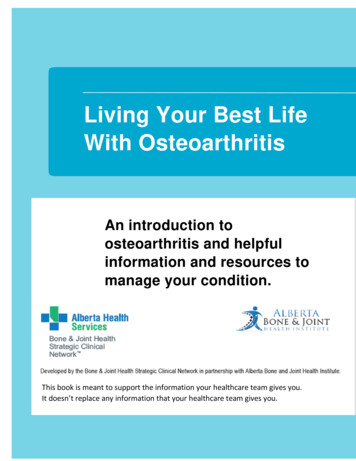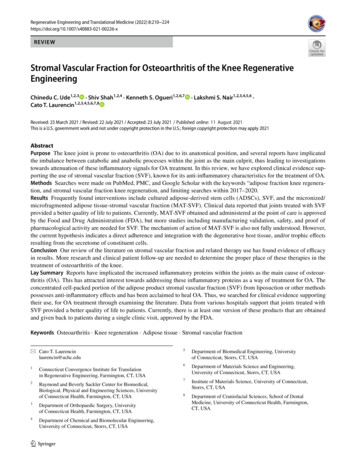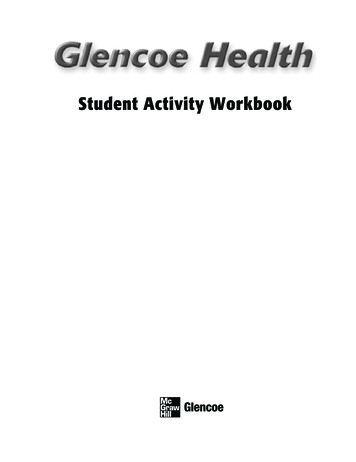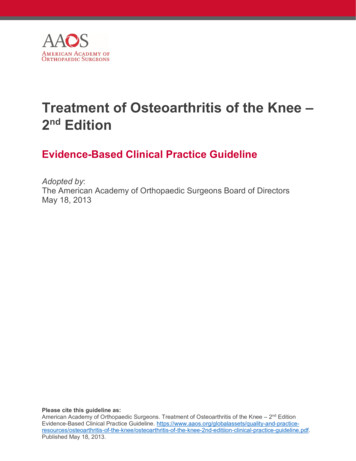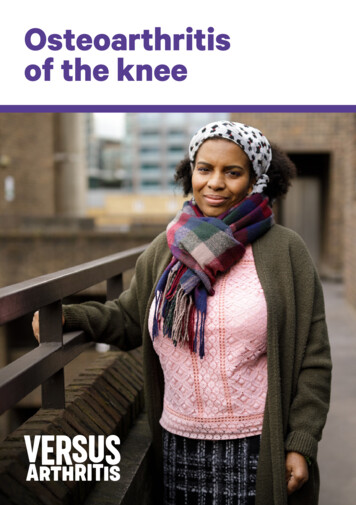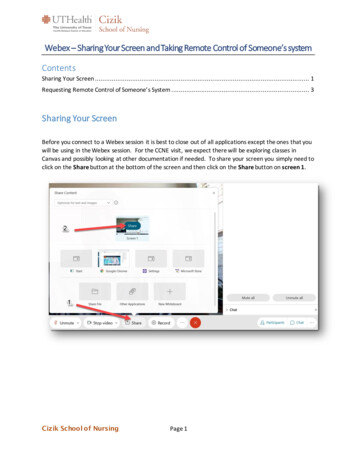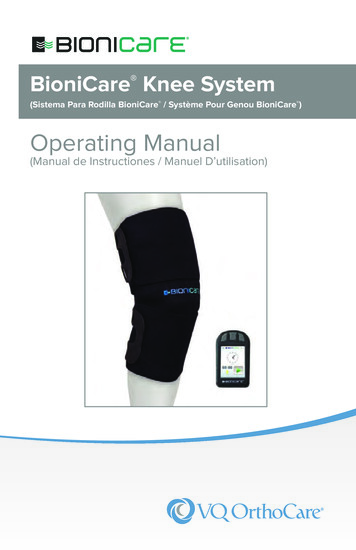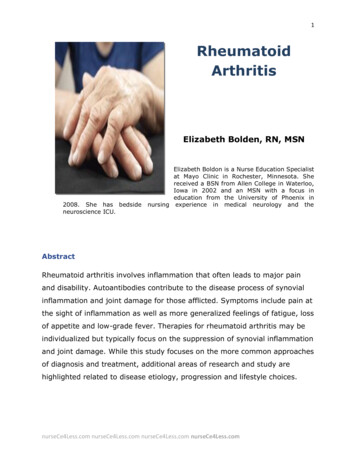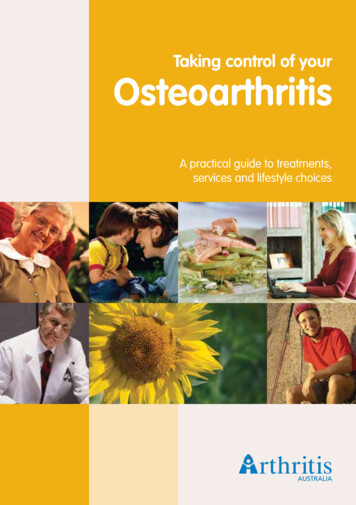
Transcription
Taking control of yourOsteoarthritisA practical guide to treatments,services and lifestyle choices
How can this booklet help youThis booklet is designed for people who haveosteoarthritis.It will help you understand yourcondition so that you can bettermanage your symptoms and continueto lead an active and healthy life.This booklet offers information andpractical advice to help you: understand what osteoarthritis isand what it means for you work with your healthcare teamto reduce symptoms such as jointpain and stiffness choose activities that areappropriate to your situation understand how your medicinescan help in the short and long term find support to cope with theemotional and lifestyle impacts ofosteoarthritis.The information inside is basedon the latest research andrecommendations. It has also beenreviewed by Australian experts inthe field of arthritis to make sure thecontents are current and relevantto your needs. So go ahead — takecontrol of your osteoarthritis! Copyright Arthritis Australia 2009. Reviewed November 2016.Original booklet produced by: Indegene Australia Pty Ltd2Taking control of your Osteoarthritis
ContentsUnderstanding osteoarthritis4Who can help?8Working with your GP10Seeing a rheumatologist11Other health professionals12Healthy moves for your joints15Making the most of medicines19What other treatments can help?22Seeking support25Glossary of terms28Useful resources29Medical and consumer consultantsDr David Hunter, Professor of Rheumatology, University of SydneyDr Paul Bird, RheumatologistMs Tanya deKroo, Information Resources Coordinator, Arthritis AustraliaDr Mona Marabani, Rheumatologist and President of Arthritis Australia (2007-2010)Ms Jean McQuade, Manager, Health & Education Services, Arthritis WADr Peter Nash, RheumatologistMrs Judith Nguyen, Arthritis Australia Board MemberDr Peter Youssef, Rheumatologist and Chair of Arthritis Australia Scientific Advisory CommitteeArthritis Australia3
Understanding osteoarthritisWhat is osteoarthritis?Osteoarthritis (OA) is the mostcommon form of arthritis, affectingmore than 1.8 million Australians. Itcan appear at any age, but tends tooccur more commonly in women andin people aged over 40 years or thosewho have had severe joint injuries.It is a condition that affects thewhole joint including bone, cartilage,ligaments and muscles.Osteoarthritisis the mostcommon formof arthritis,affecting morethan 1.8 millionAustraliansOsteoarthritis may include: inflammation of the tissue arounda joint damage to joint cartilage - thisis the protective cushion on theends of your bones which allowsa joint to move smoothly bony spurs growing around theedge of a joint deterioration of ligaments (thetough bands that hold your jointtogether) and tendons (cords thatattach muscles to bones).Whatever the cause, the symptomsof OA can include joint pain,swelling, stiffness and, in some cases,a feeling that the joint might lock orgive way.Osteoarthritis is not the same asosteoporosis — a condition where4Taking control of your Osteoarthritisthe bones become thin and are morelikely to break — although sometimespeople can have both conditions.OA tends to come on slowly, overmonths or even years. The joint painor stiffness is usually worst with activityinitially but can be more constant inlater disease. These symptoms mayaffect your ability to do normal dailyactivities, such as walking, climbingstairs and opening jars.The symptoms of OA can vary fromperson to person and depend onwhich joints are affected. Manypeople have OA without noticing any
symptoms. For those people whodo experience symptoms, the mostcommon sites are the fingers and thejoints that support the weight of yourbody — your spine (backbone), hipsand knees (see the diagram).What causes osteoarthritis?Research shows there are somethings that may put you at more riskof developing osteoarthritis (OA) incertain joints, such as: Knees: being overweight; havinga previous knee injury; jobsinvolving kneeling, climbing andsquatting. Hips: being overweight; having aprevious hip injury; jobs involvinglifting heavy loads (includingfarming); having a history of OAin the family. Hands: having a history of OAin the family; occupation; injury,being overweight.Growing older also increases thelikelihood of developing osteoarthritis.Whatever the cause, the mainproblem with OA is the pain, stiffnessand loss of mobility that comes withthe disease. This can stop you fromdoing the things you need to do orwant to do.Being overweight increasesyour risk of osteoarthritis.The heavier you are, thehigher the risk.Arthritis Australia5
Understanding osteoarthritisHow will osteoarthritisaffect me?Osteoarthritis (OA) affects differentpeople in different ways. For manypeople, OA may not cause significantproblems, or can be easily managedwith exercise and medication. Yoursymptoms may not worsen over time,but sometimes the condition willslowly progress, leading to increasedpain and reduced function.If not managed effectively, thesymptoms of osteoarthritis can limityour ability to complete normaltasks or to move about, reducingindependence and enjoyment of life.A loss of mobility may also lead todepression and/or weight gain, whichcan then lead to a cycle of worseningpain and function. However, onlya relatively small number of peoplehave to give up work or home dutieson account of their osteoarthritis.While there is no ‘cure’ forosteoarthritis, early and ongoingtreatment will help reduce symptomsand maintain your ability touse the affected joints. Medicalmanagement includes medicines,6Taking control of your Osteoarthritisjoint injections and lifestyleadvice — these are discussed indetail in the following sections.Joint replacement surgery may bean option for people who havesignificant damage to their joints,particularly their hips and knees.While there is no ‘cure’for osteoarthritis, earlyand ongoing treatmentwill help reducesymptoms
Understanding osteoarthritisHow will my doctordiagnose osteoarthritis?Doctors assess many factors to helpthem decide whether a person hasosteoarthritis. Your GP or specialistmay:Doctors assess manyfactors to help them decidewhether a person hasosteoarthritis talk to you about your symptoms,including where and when youfeel joint pain, and whether thepain feels better or worse whenyou move ask if there is any family historyof joint problems, and whetheror not the sore joint has beenpreviously damaged at work orduring sport, for instance carefully examine your sore joints,which may include moving themand feeling or listening for anysigns that the bones are rubbingagainst each other send you to a radiologist for anx-ray of the affected joints drain some fluid from your jointif it is swollen and send a sampleof the fluid for analysis. This doesnot happen frequently.Arthritis Australia7
Who can help?Counsellor orpsychologistYour doctorArthritis information& support groupPhysiotherapistPharmacistYourfriends stWeight lossspecialistExercisephysiologistThe good news is that OA can beeffectively managed - and a teamapproach is the best way to combatit. This involves you and yourhealthcare professionals togetherwith support from family, friends andcommunity organisations.Contact your State/Territory ArthritisOffice on 1800 011 041 for guidance.They can provide information andintroduce you to support groups,exercise programs and other arthritismanagement services.Arthritis Australia has a websitewww.MyJointPain.org.au to helpyou manage your osteoarthritis. Byanswering a few questions at thestart, the website will provide youwith recommended management8Taking control of your pproaches that will be most helpfulto your situation.The key to managing your OA is bystaying in control and the websiteencourages you to do this byreturning every week to report yourpain and weight. Every month, you’llbe asked additional questions whichwill help you see what treatments areworking and also allow the websiteto provide other guidance.You can also find healthcare providersin your area who can supportyou along with lots of detailedinformation and videos.Arthritis Australia also has a range ofinformation sheets about treatmentsfor osteoarthritis available atwww.arthritisaustralia.com.au
How can you help?Remember, you are the mostimportant member of your healthcareteam. By understanding yourcondition and learning how tomanage it, you can carry on livinga normal life. Work closely withyour healthcare team to develop amanagement plan for your arthritis,that may include medicines andother treatments. This will help yoube actively involved in your care anddecision-making about treatments.OA doesn’t have to get in the wayof working, travelling, relationships,pregnancy or parenting. Believingthat you can improve your conditionisn’t just wishful thinking – it actuallyhelps reduce your symptoms. Peoplewho believe that they are in controlof their OA, and become activelyinvolved in managing it, report lesspain and better function than peoplewho are less involved.information and introduce you tosupport groups, exercise programsand other arthritis managementservices. See Arthritis Australia’s rangeof information sheets for more abouttreatments for osteoarthritis.Understand how yourtreatments will help and howto get the most out of themUnderstand how your treatments willhelp and how to get the most outof them. Your healthcare team canaddress your concerns and providepractical advice. Contact yourState/Territory Arthritis Office on1800 011 041. They can provideArthritis Australia9
Working with your GPHow can my GP help?When should I see my GP?Your GP is an important partner inmanaging your osteoarthritis. Theycan also help you to access otherspecialists, health professionalsand services. Your GP will probablymake the initial diagnosis ofosteoarthritis and may refer you to arheumatologist (arthritis specialist) ifrequired. You should visit your GP leastevery 3–4 months once yourtreatment is underway.Once your osteoarthritis is fullyassessed, your GP or specialist mayprepare a care plan to manage theservices and treatments you require.They may prescribe medicines andother lifestyle changes to improveyour symptoms, and will also see youregularly to check on your treatmentand its progress.Your GP may employ a practicenurse, who may coordinate your careand access to services.How do I find a GP?If you don’t have a regular GP, findone who can support you. Speakto your local practice or medicalcentre or use the Find a Health CareProfessional section ofwww.MyJointPain.org.au10Taking control of your Osteoarthritis Visit your GP immediately if younotice a sudden worsening insymptoms or disability, or if otherjoints become affected.If you don’t have aregular GP, find one whocan support you.
Seeing a rheumatologistHow can a rheumatologisthelp?How do I find arheumatologist?Rheumatologists are doctors whospecialise in problems of the jointssuch as osteoarthritis. Your GP mayrefer you to a rheumatologist if: Your GP can refer you to arheumatologist — they will then stayin touch to coordinate your care Your GP may recommend arheumatologist Visit the Find a Health CareProfessional section atwww.MyJointPain.org.au to finda rheumatologist near you (but youwill need a referral from your GP) the cause of your symptoms isunclear your symptoms are not improvingor are worsening you require an injection into yourknee joint you and your GP are unsure if youwill require surgery you and your GP wish to seekadvice about newer treatments.While your GP may have prescribedsome medicines to reduce pain,the rheumatologist might alsorecommend other medications tocontrol your symptoms.Because every person’s osteoarthritisis different, your rheumatologist willprobably select different treatmentsover time to find the best one for you.Your GP or rheumatologistmay also refer you to other therapists for further advice onappropriate exercise and activities an orthopaedic surgeon to assessyour need for additional treatmentsuch as joint replacement surgery. You can also contact theAustralian RheumatologyAssociation on (02) 9252 2356 orvisit www.rheumatology.org.auto find a rheumatologist (butyou will still need a referralfrom your GP).When should I see myrheumatologist? Your rheumatologist may initiallywant to see you every 2–3 weeksto work out how well you areresponding to treatment You may also need to return to therheumatologist if your symptomscontinue despite your treatment,or if the pain or loss of functionin your joints causes majorinterference in your life.Arthritis Australia11
Other health professionalsHow can other healthprofessionals help?Many people with osteoarthritis visita physiotherapist (physio). Thesepractitioners will show you exercises todo at home to strengthen and stretchthe muscles in your joints and improveyour function. They will also show youpain relief techniques to use at home,including the use of heat packs andwalking sticks, to keep your joints asflexible andpain-free as possible.An exercise physiologist can give youadvice about exercise, including howto get started safely and the best typeof exercise for your health and ability. Ifyou need to lose weight, they can alsodesign an exercise program to workalongside a healthy diet.If you are overweight, losing weightis key to managing osteoarthritis. Adietitian can give you tailored adviceto assist with weight loss.You might also visit an occupationaltherapist (OT), or they may come toyour home or work. OTs can provideadvice on how to do things in a waythat reduces joint strain and pain.They may also suggest changes toyour house, like adding handrails, oraids, such as splints, that can make lifeeasier and protect your joints.12Taking control of your OsteoarthritisA podiatrist can help take care of yourfeet. They may find ways to reducethe pain in your toes, knees or hips,perhaps by providing shoe inserts oradvice on footwear.A nurse can help you learn moreabout your condition, understand yourtreatments and provide support.A pharmacist can give you informationabout your medicines, side effects andinteractions, as well as helping you tomanage your medicines (eg. checkingdosage, managing repeats).See the section on Seeking supporton page 25 for information on healthprofessionals who can help you tocope with the emotions you may befeeling.Different people will have differentpreferences about the type of healthprofessional or therapist they wishto see. There is no ‘right’ or ‘wrong’but ensure your health professionalis qualified and registered. You cancheck the registration of many types ofhealth professionals with the AustralianHealth Practitioner Regulation Agency(AHPRA) at www.ahpra.gov.au or bycalling 1300 419 495.
Arthritis Australia13
Other health professionalsHow do I find a healthprofessional?When should I see a healthprofessional? Your GP or specialist can providea referral, or you can contact aprivate therapist directly (see page29 for information about findinga private therapist or visit the Finda Health Care Professional sectionat www.MyJointPain.org.au tofind someone in your area). You may be referred by your GPor rheumatologist. If you have private healthinsurance, your health fundmay cover part of the cost ofseeing certain private healthprofessionals. If your GP refers you to a healthprofessional as part of a careplan, you may be able to havefive sessions per year funded byMedicare. Ask your GP for moreinformation. Most health professionals areavailable in the public system(such as at a community healthcentre or public hospital). Thereis often a waiting list and you willusually need a referral from yourGP. These services are usually freeor low cost.14Taking control of your Osteoarthritis You can also see a healthprofessional if you feel you needfurther support or if you noticeyour condition or function worsens.
Healthy moves for your jointsWhile healthcare professionals canoffer a range of treatments for yourosteoarthritis, there are many thingsyou can do too. The AustralianGovernment’s Healthy Active websiteprovides straightforward suggestionsfor good eating and activity levels.Visit www.healthyactive.gov.authe strain on knee and hip joints. A10% weight loss can significantlyreduce pain levels. The Australiangovernment provides advice about theamount and kinds of foods that weneed to eat for health and wellbeing,including Australian Dietary Guidelines,at www.eatforhealth.gov.auQuitting smoking is an important firststep to help your joints — call theQuitline on 13 78 48 or visitwww.quitnow.gov.au Talk to yourdoctor or other care team membersbefore making changes.Information to help with weight losscan also be found atwww.8700.com.auEating wellWhat foods are good or bad forosteoarthritis?There is very little evidence thatparticular foods are good or bad forpeople with osteoarthritis and thereis certainly no diet proven to ‘cure’it. Eating a balanced diet that is lowin saturated fat, sugar and salt, buthigh in omega-3 (from fish and otheroils), fruit, vegetables and cerealsis good for most people. If you areoverweight it is important to loseweight as this will significantly reduceFor help in working out the bestthings to eat, you can ask your GPto refer you to a dietitian or find onedirectly via the information on page29 of this booklet.For more information about diet andOA visit www.MyJointPain.org.au/treatments/nutritionEating a balanced dietthat is low in saturated fat,sugar and salt, but high infruit, vegetables, some fishand cereals is good for mostpeopleArthritis Australia15
Healthy moves for your jointsFish oilsCurrent research suggests thatfoods rich in omega-3 fats can helpreduce inflammation in some formsof arthritis and may help controlsymptoms of osteoarthritis. Foodsrich in omega-3 fats include oilyfish like sardines and salmon, pluscanola oil and walnuts. If you can’teat these foods regularly, daily fish oilsupplements which provide omega-3(containing a minimum of 180mgEPA plus 120mg DHA) may be usefulfor osteoarthritis.For more information about diet andOA visit www.MyJointPain.org.au/treatments/nutritionKeeping activeWhat exercise should I be doing?Regular physical activity benefitseveryone, whether or not they haveOA. It helps to reduce your pain,strengthen your muscles, maintainjoint function and improve your sleepand overall health.16Taking control of your OsteoarthritisRegular physical activity helpsto reduce pain, strengthenmuscles, maintain jointfunction and improve sleepand overall health
Healthy moves for your jointsInflammation in your muscles,tendons and other tissues maymake it harder for you to stand upstraight, turn and bend, or take adeep breath. Your physio or exercisephysiologist can suggest suitableexercises to stretch and strengthenyour muscles. These exercises willimprove your posture and help tomaintain flexibility. You should aim todo this stretching program every day,or at least five times per week.In addition to your stretching andmuscle strengthening exercises, it isimportant to do at least 30 minutesof moderate exercise on most daysof the week for your general fitness.You can do this either in one goor break your exercise into smallerefforts (for instance, three 10-minuteor two 15-minute blocks per day).or at the local gym or swimmingpool.Ask your State/Territory ArthritisOffice (call 1800 011 041) aboutappropriate exercise programs inyour local area, including communitygroups, swimming pools, sportscentres or gyms that run programsspecifically for peoplewith arthritis.For more information about exerciseand osteoarthritis ivities that are likely to be goodfor your fitness include walking,swimming, water exercise,low-impact aerobics, and riding abike or exercise bike. Your physio orexercise physiologist can also suggestspecific exercises and stretches thatare appropriate for your situation.Ask your physio or exercisephysiologist to create a specialexercise program you can do at homeArthritis Australia17
Healthy moves for your jointsWhat if it hurts to exercise?The level and type of exercise youwill be able to do varies from personto person — while some people canaim to keep or improve their fitnessthrough exercise, others may beaiming to remain mobile.It’s normal to feel some pain in yourmuscles when you start an exerciseprogram, or change to differenttypes of activity. However, if painfeels unusual or severe, or lasts formore than two hours after you havestopped an activity, it is probablybest to avoid or change that activity.Applying a heat or cold pack to asore joint may ease swelling and/orpain.Try to plan your exercise for timeswhen you are experiencing the leastpain — generally when youare least tired and your medicine ishaving maximum effect.18Taking control of your OsteoarthritisIt’s normal to feel some pain inyour muscles when you startan exercise program
Making the most of medicinesWill medicine cure myosteoarthritis?At present there is no ‘cure’ forosteoarthritis. Some people maynot need medicines for theirosteoarthritis, or may only needto use medications at times whensymptoms are troublesome. However,for people whose osteoarthritisis constantly painful or is slowlyworsening, finding the rightmedicines can help reduce pain,maintain the function in your jointsand improve your quality of life.What is the right medicinefor me?All medicines have risks and benefits,so before you start treatment talkto your doctor about how eachmedicine should be helping you andwhat risks it might have. Make sureyour doctor knows about any otherhealth problems that you or yourfamily members have, and what othermedication you are taking, includingany complementary medicines. Thisinformation will help them choosethe best medicine for you.the medicine might have, includingwhat to do or who to speak to if youexperience any unwanted effectsfrom your medication. Many arthritismedicines need to be taken regularlyto work properly and should not bestopped suddenly — talk to yourdoctor if you have concerns aboutside effects, safety or cost.For people with constantlypainful or slowly worseningosteoarthritis, finding theright medicines can helpreduce pain, maintainfunction and improvequality of lifeYou should also make sure thatyou understand what side effectsArthritis Australia19
Making the most of medicinesEach person responds differently toarthritis medicines, which means thatyou will need to work with your GPor rheumatologist to find the bestmedications and doses for you. Thiscan take time, but by finding themost effective medicines with theleast side effects you can hope toreally make a difference in controllingyour osteoarthritis.Your condition may also changeover time, including which joints areaffected, how much pain or disabilityyou experience, and whether youhave symptom-free periods. Thismeans that you may need to changeor add medicines over the course ofyour treatment — you may not be onthe same medicine forever.recommended dose. However takingmore than the recommended dailydose can potentially cause severeliver problems. Ask your doctor orpharmacist for advice. You may alsofind short-term relief from analgesiccreams that can be rubbed intothe painful joints.For stronger pain, a groupof medicines called NSAIDs(anti-inflammatory drugs) canhelp, and they also reduce swellingand stiffness. A certain type ofanti-inflammatory drugs calledCOX-2 inhibitors are effective inreducing arthritis pain and may beless likely to cause stomach problems.If pain is severe, strong pain-relievingmedicines such as opioidsmay be used.How will the medicineshelp?Some people with osteoarthritisfind that their pain can be managedby regular use of pain-relievingmedicines (analgesics) such asparacetamol, although new researchis casting doubt on how usefulit is for relieving osteoarthritisrelated pain. Paracetamol has fewside effects when taken at the20Taking control of your OsteoarthritisFor stronger pain, agroup of medicinescalled NSAIDs can help
Making the most of medicinesHow do I find out moreabout these medicines,including side effects?To understand more about yourmedicines and any risks or sideeffects that they may have, read theConsumer Information Medicine(CMI) leaflet that is available fromyour doctor or pharmacist. CMIleaflets provide easy to understandinformation including what themedicine is for and how it is used;things to consider before using themedicine; and possible side effectsand what to do if they occur. Speakto your GP or specialist, especially ifyou have concerns about thelong-term effect of medicines, howthey might affect your pregnancyplans (whether you are male orfemale), or whether they shouldbe taken during pregnancy orbreastfeeding.Call the Arthritis Infoline on1800 011 041 for copies or visitwww.rheumatology.org.au orwww.arthritisaustralia.com.auFor detailed information aboutanalgesics, NSAIDs and COX-2medication visit www.MyJointPain.org.au/treatmentsCMI leaflets provide easyto understand informationabout risks or side effects ofmedicationsMore information about individualmedicines can also be found atwww.nps.org.auThe Australian RheumatologyAssociation and Arthritis Australiapublish information sheets aboutmany arthritis medicines.Arthritis Australia21
What other treatments can help?What other treatments can Itake to ease osteoarthritis?There are many promises made fornon-medical ‘cures’ or treatmentsto ease arthritis — some of thesemay work but many have not beenproven to help. Glucosamine and/or chondroitin supplements mayimprove pain slightly in the shortterm (less than six months). Howevermany studies of these supplementsshow no benefit. See ArthritisAustralia’s Glucosamineand chondroitin informationsheet for more details atwww.arthritisaustralia.com.auAcupuncture has been shown to helpreduce knee pain in osteoarthritis.Ensure your practitioner is qualifiedand registered. Most therapies havea professional association you cancontact for more information orthey can help you find an accreditedpractitioner. Some qualifications,for example Chinese MedicinePractitioners, can be checked atthe Australian Health PractitionerRegulation Agency (AHPRA)www.ahpra.gov.au or by calling1300 419 495.22Taking control of your OsteoarthritisBecause herbal, homeopathic,Ayurvedic or Chinese medicines mayaffect the treatments prescribed byyour doctor, please tell your GP andspecialist what other treatments youare thinking about using.You may feel concerned that yourdoctor or other members of yourhealthcare team may disapprove ofcomplementary therapies. Howeverit is very important to keep yourhealthcare team informed, evenif they may not approve. Yourhealthcare team, particularly yourdoctor and pharmacist, can’t giveyou the best professional advicewithout knowing all the treatmentsyou are using. This includes vitaminsupplements, herbal medicines andother therapies.See Arthritis Australia’sComplementary therapiesinformation sheet for more about thesafe use of these types of treatmentsat www.arthritisaustralia.com.au orvisit www.MyJointPain.org.au/treatments
Are joint injections helpfulto ’fix’ joints?Apart from surgically replacing theaffected joint with an artificial joint,there is no treatment that can restorethe lost cartilage in your joints.However, some joint injections mayhelp reduce symptoms and improvemovement, particularly in theknee. An injection of corticosteroidmedication into the joint during a‘flare’ can provide short-term painrelief (usually two to four weeks)and help you return to an exerciseprogram or normal activity.The rheumatologist may also inject aliquid called hyaluronan, which helpsto ‘lubricate’ your joint to stop thebones rubbing against each other.Joints should be treated gently fora few days after each injection, butotherwise the risk of infection ordamage to the joint is relatively small.Results from scientific studies do notclearly prove if this type of treatmentis beneficial.Further information about jointinjections for osteoarthritis can befound at www.MyJointPain.org.au/treatmentsArthritis Australia23
What other treatments can help?When should I think aboutjoint replacement surgery?In this kind of surgery your own jointis replaced with an artificial one.It should be used only when othertreatments, including weight loss,don’t work for you. Joint replacementmay be an option if: You have severe, constant jointpain that does not improve withrest, medication, exercise or othertreatments You have pain at night time thataffects your ability to sleep You have major limitations ofwalking and other daily activities,such as showering and dressing. Your ability to work or look afterpeople who require your care isreduced.If you can’t manage your symptomswith other treatments, talk to yourdoctor about whether a referral toan orthopaedic surgeon (a doctorwho operates on joints) would bebeneficial. The surgeon will assesswhether joint replacement is likely towork for you, including how fit youare and any other medical conditionsthat might rule out surgery.24Taking control of your OsteoarthritisYour orthopaedic care team willalso talk to you about possible risksassociated with joint replacementsurgery, as well as what you cando to give your new joint the bestchance of long-term success.After recovery from the surgery,which usually takes a few months,the new joint should result in a lesspainful and more mobile joint for atleast 10 years.For people with osteoarthritis of theknee, arthroscopy (keyhole surgery)is not an effective treatment for painand is not recommended unless yourknee locks.Further information about jointreplacement surgery can be foundat www.MyJointPain.org.au/treatments or Arthritis Australia’sJoint replacement booklet atwww.arthritisaustralia.com.a
Dr David Hunter, Professor of Rheumatology, University of Sydney Dr Paul Bird, Rheumatologist Ms Tanya deKroo, Information Resources Coordinator, Arthritis Australia Dr Mona Marabani, Rheumatologist and President of Arthritis Australia (2007-2010) Ms Jean McQuade, Manager, Health & Education Services, Arthritis WA Dr Peter Nash, Rheumatologist
